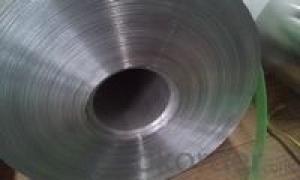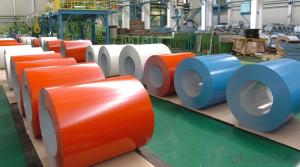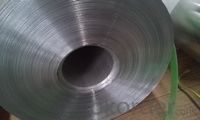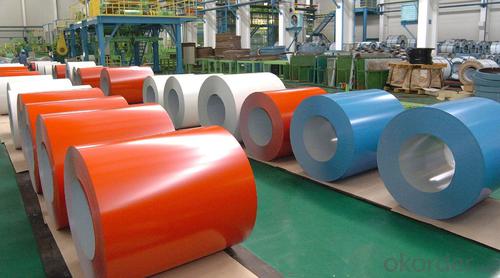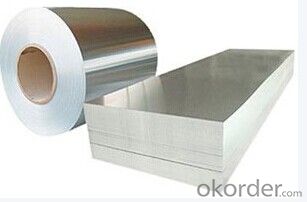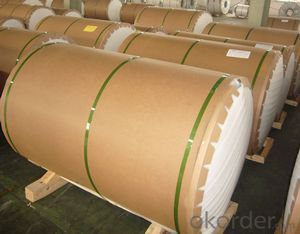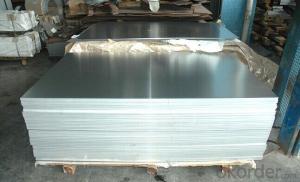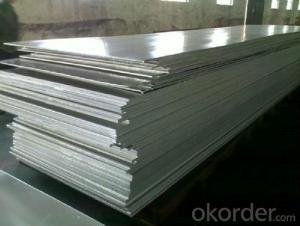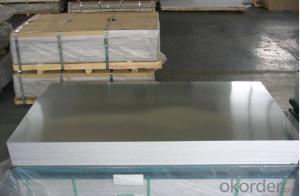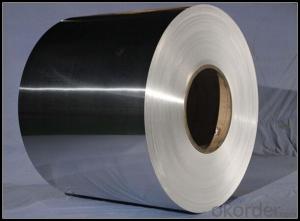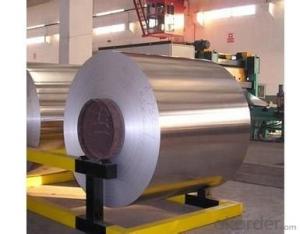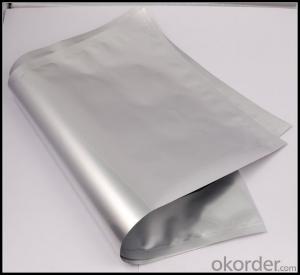1060 Aluminum Coil Price AA1050 Anodising Coated Aluminum Sheet
- Loading Port:
- China Main Port
- Payment Terms:
- TT OR LC
- Min Order Qty:
- -
- Supply Capability:
- -
OKorder Service Pledge
Quality Product, Order Online Tracking, Timely Delivery
OKorder Financial Service
Credit Rating, Credit Services, Credit Purchasing
You Might Also Like
supply Mill-finished / coated aluminum sheet/ coil:
Alloy: AA1050,1060,1100,1200,2024,3003,3304,3005,3015,5052,5086,5754,5083,6061,7050,7475,8011, etc
Temper: O, H14/16/18/22/24/32/ H112/H321/T6,T851,T7451,T7351, etc
Thickness: 0.02mm—20mm
Width: 100mm—2000mm (Can be slitted)
Notice: PE coating / PVDF coating / Embossment can be done if required.
- Q: I have a broken exhaust stud in my engine head. I have an aluminum head but the stud is steel. The stud broke a little below the surface. I want to mig weld a washer to the stud, but will the weld stick to the aluminum or will it blow a big hole in the head? I will only be using a little 110 mig welder.will I be okay or will that lead to more problems?
- Drill a hole in the center of the stud. Then go buy a bolt extractor bit. With welding you risk damaging the head and or warping the internal threads.
- Q: what is aircraft grade aluminum?
- This Site Might Help You. RE: what is aircraft grade aluminum? what is aircraft grade aluminum?
- Q: How are aluminum coils protected against galvanic corrosion?
- Aluminum coils are protected against galvanic corrosion through various methods, such as applying a protective coating or using sacrificial anodes. These measures help to create a barrier between the aluminum and other metals, preventing the occurrence of galvanic corrosion.
- Q: What are the common methods of joining aluminum coils together?
- Depending on the desired outcome and specific application, there are various ways to join aluminum coils together. One frequently employed technique is welding, which involves melting the edges of the aluminum coils together using heat. Gas tungsten arc welding (GTAW) or gas metal arc welding (GMAW) are some of the techniques used for this purpose. Welding creates a strong and durable joint, but it is time-consuming and requires skilled operators. Another approach is adhesive bonding, where a specially formulated adhesive is applied between the aluminum coils to create a bond. This method is often used for lightweight applications and provides a joint with excellent strength and flexibility. However, it may necessitate surface preparation and curing time for the adhesive to fully set. Mechanical fastening techniques like riveting or bolting can also be utilized to join aluminum coils. Riveting involves inserting a rivet through drilled holes in the coils and deforming it to secure the joint. Bolting, on the other hand, involves using screws or bolts to hold the coils together. Mechanical fastening methods offer a strong joint and are relatively quick to implement, but they may require additional hardware and can create stress concentration points. Another method involves using a crimping or roll forming technique. This technique employs specialized machinery to apply pressure to the aluminum coils, creating interlocking joints or folds. Crimping or roll forming is commonly used in roofing, siding, or gutter systems and provides good strength and weather resistance. However, it may necessitate specific equipment and expertise. To summarize, the common methods for joining aluminum coils include welding, adhesive bonding, mechanical fastening, and crimping/roll forming. Each method has its own advantages and considerations, so the choice should be based on the specific requirements of the application.
- Q: What are the potential challenges in recycling aluminum coils?
- Recycling aluminum coils presents several potential challenges that need to be addressed. To begin with, the removal of contaminants such as paint, oil, or other coatings from aluminum coils is a crucial step before the recycling process can commence. This task can be both time-consuming and costly as it requires thorough cleaning to ensure the quality of the recycled aluminum. Furthermore, the presence of mixed materials like steel or plastic in aluminum coils complicates the recycling process even further. These materials must be separated from the aluminum before it can be melted down and recycled. This separation necessitates specialized equipment and expertise, thereby increasing the cost and complexity of recycling aluminum coils. Transportation and logistics also pose a significant challenge in recycling aluminum coils. Their large and heavy nature makes it challenging and expensive to transport them to recycling facilities. Additionally, these facilities must possess suitable infrastructure to handle and process the coils efficiently. Moreover, the fluctuating market prices of aluminum contribute to the challenges in recycling aluminum coils. The value of recycled aluminum is influenced by global supply and demand, which can vary greatly over time. This unpredictability makes it difficult for recyclers to accurately predict the financial returns from recycling aluminum coils, potentially impacting the viability of the recycling process. Lastly, the overall awareness and participation in aluminum coil recycling present a challenge. Many industries and individuals may lack awareness regarding the benefits of recycling aluminum coils or may not have access to recycling facilities. Overcoming this challenge requires increasing education and improving accessibility to recycling programs, thereby promoting the sustainable recycling of aluminum coils.
- Q: What are the maximum and minimum coil weights available?
- The maximum and minimum coil weights available vary depending on the specific product and supplier. It is best to consult with the supplier or check the product specifications for accurate information on the available coil weight ranges.
- Q: Can aluminum coils be used in high-humidity environments?
- Yes, aluminum coils can be used in high-humidity environments. Aluminum is a corrosion-resistant metal, making it suitable for applications in areas with high humidity levels. The natural oxide layer that forms on the surface of aluminum acts as a protective barrier against moisture and prevents the metal from rusting or corroding. This makes aluminum coils a popular choice for HVAC systems, where they are exposed to moisture and humidity on a regular basis. Additionally, aluminum coils are lightweight, durable, and have excellent heat transfer properties, making them an ideal choice for various industrial and commercial applications in high-humidity environments.
- Q: What are the different types of surface treatments for aluminum coils?
- Aluminum coils can undergo various surface treatments to enhance their appearance, durability, and resistance to corrosion. Let's explore the different types of treatments available: 1. Anodizing: This method involves forming a protective oxide layer on the aluminum surface. Anodizing can be performed in different colors, adding an aesthetic touch to the coils. Additionally, it improves resistance against corrosion and wear. 2. Painting: High-quality paints can be applied to aluminum coils to provide both decorative and protective finishes. A wide range of colors and finishes, such as matte, gloss, or metallic, can be chosen. Painting not only enhances appearance but also offers additional protection against corrosion and UV rays. 3. Powder Coating: In this process, a dry powder is electrostatically applied to the aluminum coils and then cured under heat. Powder coating provides a durable and attractive finish that resists chipping, scratching, and fading. It comes in a variety of colors and textures. 4. Chemical Conversion Coating: This treatment involves applying a chemical solution to the aluminum surface, resulting in a thin protective layer. The conversion coating enhances corrosion resistance and provides a suitable base for subsequent paint or powder coating. 5. Brushing: Brushing is a mechanical treatment that utilizes abrasive brushes to create a textured finish on aluminum coils. This technique achieves a brushed or satin-like appearance, adding a unique aesthetic appeal. 6. Embossing: By creating raised patterns or textures on the aluminum surface, embossing enhances both visual appeal and the strength and stiffness of the coils. Embossed coils are often used in architectural and decorative applications. Ultimately, the choice of surface treatment for aluminum coils depends on specific requirements and desired appearance. Each treatment offers distinct benefits in terms of durability, corrosion resistance, and aesthetic appeal.
- Q: This question asks for methods to prevent rusting on aluminum coils during storage and transportation.
- <p>To prevent rusting on aluminum coils during storage and transportation, ensure that the coils are clean and dry before storage. Use a protective coating or wrapping to shield them from moisture and contaminants. Store the coils in a cool, dry place away from direct sunlight and corrosive substances. Avoid stacking them where they may come into contact with acidic materials. During transportation, secure the coils properly to prevent movement that could lead to scratches or damage. Use moisture-resistant covers to protect them from the elements. Regularly inspect the coils for signs of corrosion and address any issues promptly.</p>
- Q: Can aluminum coils be used in the production of solar reflectors?
- Yes, aluminum coils can be used in the production of solar reflectors. Aluminum is a commonly used material in the manufacturing of solar reflectors due to its high reflectivity and durability. The coils can be processed and shaped into the desired form for the reflector, allowing for efficient reflection of sunlight onto the solar panels. Additionally, aluminum is lightweight, making it easier to handle and install in solar reflector systems.
Send your message to us
1060 Aluminum Coil Price AA1050 Anodising Coated Aluminum Sheet
- Loading Port:
- China Main Port
- Payment Terms:
- TT OR LC
- Min Order Qty:
- -
- Supply Capability:
- -
OKorder Service Pledge
Quality Product, Order Online Tracking, Timely Delivery
OKorder Financial Service
Credit Rating, Credit Services, Credit Purchasing
Similar products
Hot products
Hot Searches
Related keywords
